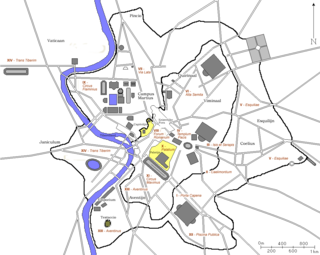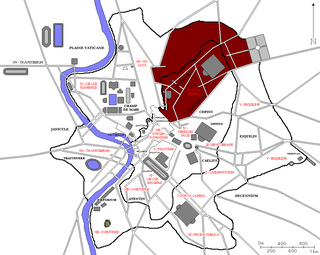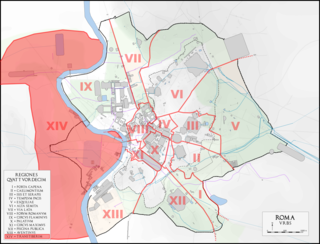
The Regio II Caelimontium is the second regio of imperial Rome, under Augustus's administrative reform. It took its name from the Caelian Hill, which the region was centred on.

The Regio II Caelimontium is the second regio of imperial Rome, under Augustus's administrative reform. It took its name from the Caelian Hill, which the region was centred on.
According to Livy, during the reign of Tullus Hostilius, the entire population of Alba Longa was forcibly resettled on the Caelian Hill. [1] In Republican-era Rome the Caelian Hill was a fashionable residential district, site of residences of the wealthy. Archaeological work under the Baths of Caracalla has uncovered the remains of lavish villas complete with murals and mosaics. A significant area of the hill is taken up by the villa and gardens of Villa Celimontana. The Caelian Hill is the site of the Basilica of Santi Giovanni e Paolo and the ancient basilica of Santo Stefano Rotondo.
At the turn of the 5th century, the regio was divided into seven vici (districts) and 3,600 insulae (blocks). It had two curators and was served by 48 Roman magistrates. [2]

Regio II largely followed the contours of the Caelian Hill. To the west, its boundary was the Via Tusculana, and the south was eventually enclosed by the Aurelian Walls, through which two gates passed: the Porta Metronia and the Porta Asinaria. A measurement taken at the end of the 4th century recorded that the perimeter of the region was 12,200 Roman feet (approximately 3.61 km). [3]
The region was dominated by the Temple of Claudius, which occupied much of the Caelian Hill. The region also contained the Macellum Magnum (or Great Market), the station of the fifth cohort of the Vigiles , and the Castra Peregrina. [4] Also mentioned as being situated here was the Caput Africae, probably an educational and training institution (paedagogium) for young boys who would serve as imperial staff. A grotto, the Antrum Cyclopis was also present, situated in the side of the hill.
At the turn of the 5th century, the regio contained seven aediculae (shrines), 127 domūs (patrician houses), 27 horrea (warehouses), 85 balneae (bath houses) and 65 loci (fountains). [2] It also contained the ludus matutinus, a gladiator school. [5]
The Caelian Hill is one of the famous seven hills of Rome.

In 7 BC, Augustus divided the city of Rome into 14 administrative regions. These replaced the four regiones—or "quarters"—traditionally attributed to Servius Tullius, sixth king of Rome. They were further divided into official neighborhoods.
During the Middle Ages, Rome was divided into a number of administrative regions, usually numbering between twelve and fourteen, which changed over time.

The Porta Querquetulana or Querquetularia was a gateway in the Servian Wall, named after the sacred grove of the Querquetulanae adjacent to and just within it. The grove appears not to have still existed in the latter first century BC.

The Temple of Claudius, also variously known as the Temple of the Divus Claudius, the Temple of the Divine Claudius, the Temple of the Deified Claudius, or in an abbreviated form as the Claudium, was an ancient structure that covered a large area of the Caelian Hill in Rome, Italy. It housed the Imperial cult of the Emperor Claudius, who was deified after his death in 54 AD.

The Regio I Porta Capena is the first regio of imperial Rome, under Augustus's administrative reform. Regio I took its name from the Porta Capena, a gate of the Servian Walls, through which the Appian Way entered the city prior to the construction of the Aurelian Walls.
The Temple of Honor and Virtue was a temple in Regio I of ancient Rome dedicated to Virtus and Honos. No remains survive. It is the first entry for Regio I in the regional catalogues and was sited just outside the porta Capena, probably on the northern side of the via Appia. In front of it was the Ara Fortuna Redux.

The ancient city of Constantinople was divided into 14 administrative regions. The system of fourteen regiones was modelled on the fourteen regiones of Rome, a system introduced by the first Roman emperor Augustus in the 1st century AD.

The Regio III Isis et Serapis was the third regio of imperial Rome, under Augustus's administrative reform. Regio III took its name from the double sanctuary of Isis and Serapis, in the area of the Via Praenestina, containing the valley that was to be the future site of the Colosseum, and parts of the Oppian and Esquiline hills.

The Regio IV Templum Pacis is the fourth regio of imperial Rome, under Augustus's administrative reform. Regio IV took its name from the Temple of Peace built in the region by the emperor Vespasian. It includes the valley between the Esquiline and the Viminal hills, the popular area of the Suburra, and the Velian Hill.

The Regio V Esquiliae is the fifth regio of imperial Rome, under Augustus's administrative reform. Regio V took its name from the Esquiline Hill. It contains parts of the Oppian Hill and Cispian Hill and of the Esquiline, plus the plain just outside the Servian Wall.

The Regio VI Alta Semita is the sixth regio of imperial Rome, under Augustus's administrative reform. Regio VI took its name from the street passing over the Quirinal Hill. It was a large regio that also encompassed the Viminal Hill, the lower slopes of the Pincian, and the valleys in-between.

The Regio VII Via Lata is the seventh regio of imperial Rome, under Augustus's administrative reform. Regio VII took its name from the wide urban street the Via Lata. It was the urban section of the Via Flaminia, which ran between the Servian walls and the Aurelian Walls, and corresponds to the modern Via del Corso. The regio contained part of the Campus Martius on the east of the street plus the Collis Hortulorum, the Pincian Hill.

The Regio VIII Forum Romanum Magnum is the eighth regio of imperial Rome, under Augustus's administrative reform. Regio VIII took its name from the Roman Forum, the political centre of Ancient Rome.

The Regio IX Circus Flaminius is the ninth regio of imperial Rome, under Augustus's administrative reform. Regio IX took its name from the racecourse located in the southern end of the Campus Martius, close to Tiber Island.

The Regio X Palatium is the tenth regio of imperial Rome, under Augustus's administrative reform. Regio X took its name from the Palatine Hill and the imperial palaces located on it.

The Regio XI Circus Maximus is the eleventh regio of imperial Rome, under Augustus's administrative reform. Regio XI took its name from the Circus Maximus, located in the valley between the Palatine and the Aventine hills.

The Regio XII Piscina Publica is the twelfth regio of imperial Rome, under Augustus's administrative reform. Regio XII took its name from the Piscina Publica, a swimming pool that disappeared during the middle imperial period.

The Regio XIII Aventinus is the thirteenth regio of imperial Rome, under Augustus's administrative reform. Regio XIII took its name from the hill which dominated the region, the Aventine.

The Regio XIV Transtiberim is the fourteenth regio of imperial Rome, under Augustus's administrative reform. Meaning "across the Tiber", the Regio took its name from its position on the west bank of the Tiber River.